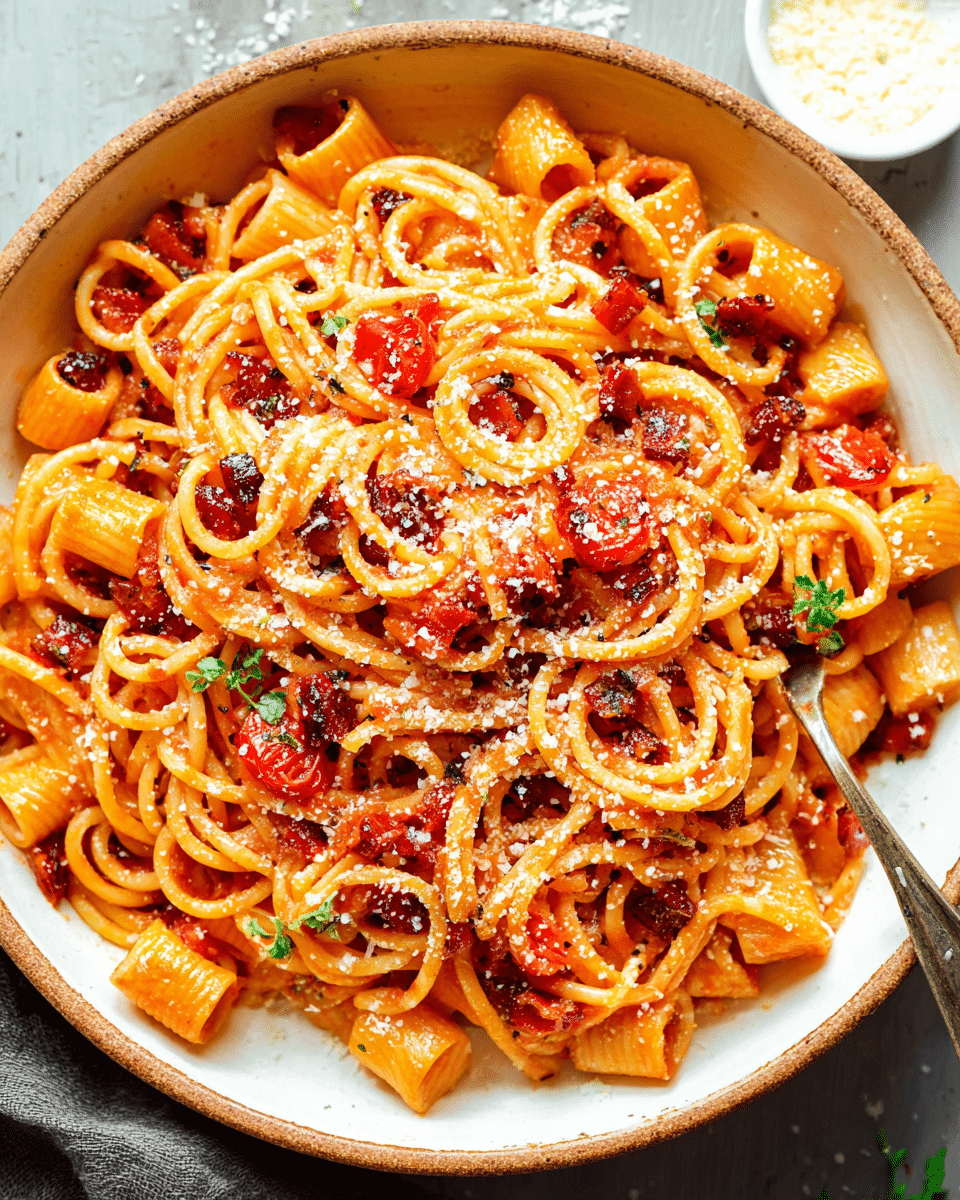Pasta all’Amatriciana is a classic Roman dish, rich with the savory flavors of crispy guanciale, tangy tomatoes, and a sprinkle of Pecorino Romano. It’s the kind of dish that captures the heart of Italian cuisine—simple, yet full of depth and character.
This dish is perfect for a cozy weeknight dinner or even a special gathering. The combination of pasta, tomatoes, and guanciale creates a symphony of flavors that will have everyone coming back for more. Whether you use bucatini or spaghetti, this Pasta all’Amatriciana is a timeless favorite that brings the warmth of Rome straight to your table.
Full recipe:
Ingredients:
-
400g pasta (such as bucatini or spaghetti)
-
150g guanciale (or pancetta, if guanciale is unavailable)
-
400g canned tomatoes (preferably San Marzano)
-
1 small onion, finely chopped
-
1/2 cup dry white wine
-
1/2 teaspoon red pepper flakes (optional, for heat)
-
1/4 cup Pecorino Romano cheese, grated
-
Olive oil for sautéing
-
Salt and pepper to taste
Directions:
-
Bring a large pot of salted water to a boil and cook the pasta according to the package instructions. Drain, reserving 1 cup of pasta water.
-
While the pasta cooks, heat a drizzle of olive oil in a large skillet over medium heat. Add the guanciale (or pancetta) and cook for about 5 minutes, until crispy and browned. Remove and set aside.
-
In the same skillet, add the chopped onion and sauté for 2-3 minutes, until softened.
-
Add the canned tomatoes, red pepper flakes (if using), salt, and pepper. Simmer for about 15 minutes, allowing the sauce to thicken.
-
Add the cooked guanciale back into the sauce and stir to combine.
-
Add the cooked pasta to the skillet, tossing to coat in the sauce. If necessary, add a bit of reserved pasta water to loosen the sauce.
-
Stir in the grated Pecorino Romano and adjust seasoning with salt and pepper.
-
Serve with extra cheese on top and enjoy!
Prep Time: 10 minutes | Cooking Time: 20 minutes | Total Time: 30 minutes Kcal: 500 kcal | Servings: 4 servings
The Origins of Pasta all’Amatriciana
The name “Amatriciana” comes from the town of Amatrice, located in the Lazio region of central Italy. The town has long been associated with this signature pasta dish, and it is here that the recipe is believed to have originated. Amatrice was historically a small farming community, where the locals would make use of the abundant and high-quality ingredients that the land provided.
While the modern version of Pasta all’Amatriciana may have evolved over time, its roots can be traced back to the 18th century. It is said that the dish was first created by shepherds in the Amatrice area, who would prepare a sauce using guanciale (cured pork cheek) and pecorino cheese, both of which were common in the region. The addition of tomatoes and pasta likely came later, as tomatoes were introduced to Italy in the 16th century and began to take hold in the country’s cuisine.
The History of Pasta all’Amatriciana
Pasta all’Amatriciana is often regarded as one of Rome’s most iconic dishes, but its origins are more closely tied to Amatrice, which is located in the province of Rieti. The recipe made its way to Rome during the 19th century, where it became a staple in Roman trattorias and restaurants. The dish’s fame spread far and wide, and today it is enjoyed not only in Italy but also around the globe.
In the early 20th century, Pasta all’Amatriciana began to take on the form we recognize today, particularly with the addition of tomatoes. In fact, the use of tomatoes in the dish has been a point of debate over the years. Some purists insist that the original recipe did not include tomatoes, but rather relied solely on the flavor of guanciale and pecorino cheese. Others argue that the inclusion of tomatoes is essential to creating the dish as we know it. Regardless of this debate, the combination of guanciale, tomatoes, and cheese has become the defining characteristic of Pasta all’Amatriciana.
Ingredients that Make Pasta all’Amatriciana Special
At its core, Pasta all’Amatriciana is a simple dish with only a few key ingredients, but each one plays an important role in creating the dish’s signature taste. The first and most important ingredient is guanciale, a type of cured pork that is made from the cheek or jowl of the pig. Guanciale has a rich, fatty texture and a delicate, slightly sweet flavor that distinguishes it from other cured meats like pancetta or bacon. The guanciale is cooked until it becomes crispy, releasing its flavorful fat, which serves as the base for the sauce.
The second key ingredient is Pecorino Romano, a sharp, salty sheep’s milk cheese that hails from the Lazio region. This cheese is grated and added to the dish at the end, providing a distinctive salty bite that complements the richness of the guanciale. The final essential ingredient is tomatoes, which provide acidity and sweetness to balance the richness of the meat and cheese.
While the dish is traditionally made with bucatini pasta, which is a thick spaghetti-like pasta with a hole running through the center, it can also be made with spaghetti or rigatoni. The pasta is boiled until al dente and then tossed with the sauce, allowing the flavors to meld together beautifully.
The Evolution of Pasta all’Amatriciana
While the original recipe for Pasta all’Amatriciana may have been quite simple, the dish has seen many variations over the years. In some versions of the dish, onions or garlic are added to the sauce for extra flavor. Some cooks even incorporate a splash of white wine or red pepper flakes to give the dish an additional layer of complexity.
Another common variation of Pasta all’Amatriciana is the use of different types of pasta. While bucatini is the traditional choice, spaghetti is often used as a substitute, especially in restaurants outside of Italy. Some modern versions of the dish might even incorporate pancetta instead of guanciale, though purists argue that this alters the flavor of the dish.
Despite these variations, Pasta all’Amatriciana remains true to its roots in the simplicity and quality of its ingredients. Whether enjoyed in Rome, Amatrice, or elsewhere, the dish has stood the test of time, evolving over centuries while retaining its classic, irresistible flavor.
Pasta all’Amatriciana in Italian Culture
Pasta all’Amatriciana is not just a dish; it is a part of Italy’s cultural identity. In Amatrice, the dish is a source of immense pride, and it is often referred to as “la pasta alla matriciana.” It is typically served during family gatherings, festivals, and holidays, and it holds a special place in the hearts of Italians.
In fact, in 2016, the town of Amatrice faced a devastating earthquake that destroyed much of the town and left many residents without homes. In response, chefs and food enthusiasts from around the world began promoting Pasta all’Amatriciana as a symbol of solidarity with the town of Amatrice. Events and campaigns were held to raise funds for rebuilding efforts, with the sale of Pasta all’Amatriciana meals helping to support the victims of the earthquake. This further cemented the dish’s place in Italian culture as a symbol of resilience and community.
How to Serve and Enjoy Pasta all’Amatriciana
Pasta all’Amatriciana is typically served as a first course (primo) in a traditional Italian meal. It is often accompanied by a glass of wine, such as a crisp white wine like Frascati or a light red like Chianti. The dish can be enjoyed as part of a larger meal, followed by a second course (secondo) of meat or fish, and rounded off with a dessert like tiramisu or panna cotta.
In addition to its traditional preparation, Pasta all’Amatriciana can be served in various creative ways. Some cooks like to add a dollop of ricotta cheese or a sprinkle of fresh herbs like basil or parsley. For a slightly spicier version, red pepper flakes can be added to the sauce for an extra kick.
Conclusion
Pasta all’Amatriciana is a timeless dish that embodies the essence of Italian cooking: simplicity, quality ingredients, and bold flavors. From its humble origins in Amatrice to its widespread popularity today, this pasta dish has become a beloved part of Italy’s culinary tradition. Whether enjoyed in the heart of Rome, in the small town of Amatrice, or at home in your own kitchen, Pasta all’Amatriciana offers a delicious and comforting experience that highlights the best of Italian cuisine.
The dish’s enduring popularity is a testament to its irresistible flavor and the cultural significance it holds for Italians and food lovers around the world. With its perfect balance of guanciale, Pecorino Romano, and tomatoes, Pasta all’Amatriciana is a dish that will never go out of style. It serves as a reminder of the rich history and culinary heritage of Italy, and its timeless appeal continues to bring people together over shared meals and memorable moments.






